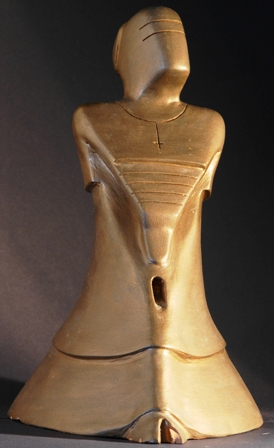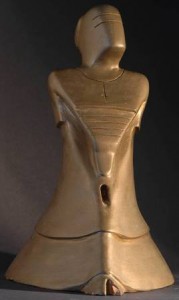
L’opera dal titolo, volutamente provocatorio, “La prostituzione di un vescovo”, realizzata nel 1997, mostra “un figuro” seduto su un cippo nell’atto, un po’ vanitoso , di concedersi alla moltitudine. La scultura vuole essere una riflessione sulla fede e sulla speranza che molti ripongono nei rappresentanti di Dio in terra.
Dal punto di vista formale si presenta nell’atteggiamento di chi in abiti succinti e le gambe incrociate è seduto lungo le strade di periferia, a vendere il proprio corpo al miglior offerente, in questo caso a mercanteggiare “la propria fede”.
Il piede, che ricorda lo zoccolo di una bestia, e le due depressioni, visibili frontalmente ai lati del busto, in luogo delle braccia, alla maniera di occhi tenebrosi e demoniaci, rivelano le profonde contraddizioni su cui poggia la “rappresentanza” terrena. Il volto assente, stilizzato, solcato da due profonde linee incise che si ripetono sul torace e che richiamano le armature medievali, conferisce alla scultura un’immagine, oramai sfocata, di un cavaliere senza tempo pronto a muovere battaglia contro tutto ciò che attenta i fondamenti della fede e lotta con tutte le armi che il Creatore gli ha donato.
La “bestialità” che si cela sotto gli abiti sacri vuole condurre il fruitore a considerare l’agire, a volte non proprio cristiano, di alcuni religiosi che, indossato l’abito talare come una divisa, lanciano moniti alla stregua di generali di un esercito.
La bocca spalancata, all’altezza dell’inguine, vuole dare voce alle numerose vittime, senza nessuna colpa apparente se non la loro diversità, di delitti commessi in nome di Dio.
Riflettere a volte sul “bigottismo”, ipocritamente celato dietro formule liturgiche e litanie superbamente ostentate, abiti sfarzosi e architetture maestose, può ridare vigore a un Dio mortificato da millenni di insensatezza religiosa in cui il Dio denaro ha spesso sostituito in terra il Dio celeste.
The prostitution of a bishop-Pasquale Mastrogiacomo
The work entitled, deliberately provocative, “the prostitution of a bishop”, built in 1997, shows a “figure” sitting on a stone in the act, a bit ‘vain, to enjoy the multitude. The sculpture is a reflection on faith and hope that many place in God’s representatives on earth.
From the formal point of view presents itself in the attitude of some in skimpy clothes and sat cross-legged along the suburban streets to sell their bodies to the highest bidder, in this case to bargain “their faith.”
The foot that reminds the hoof of a beast, and the two depressions, visible from the front sides of the bust, in place of arms in the manner of dark and demonic eyes, revealing the deep contradictions that underlie the “representation” on earth. The missing face, stylized, crossed by two deep lines etched on his chest and repeating that recall medieval armor, gives the sculpture an image, now blurred, a knight ready to move timeless battle against all that careful fundamentals of faith and fight with every weapon that the Creator has given him.
The “nonsense” that is hidden under clothes sacred wants to lead the viewer to consider the act, sometimes not very Christian of some men who wore the cassock as a uniform, has been warning the same way as an army general .
The open mouth, groin, wants to give voice to the many victims, through no fault other than their apparent diversity, for crimes committed in the name of God.
Sometimes reflect on “bigotry” hypocritically concealed behind liturgical formulas and litanies superbly ostentatious, gaudy clothes and majestic architecture, can revitalize a God humiliated by millennia of religious nonsense in which the money God has often replaced the God of heaven on earth.
